Metrics, Data & Developing Business Cases for Learning & Development
VerifiedAdded on 2023/06/10
|17
|4752
|77
Report
AI Summary
This report examines the use of information and metrics in learning and development (L&D) to develop business cases. It identifies various metrics for measuring L&D effectiveness, categorized as inputs, processes, outputs, and outcomes, including intent, knowledge, behavior, and impact. The report also evaluates primary (in-depth interviews, surveys, focus groups, social media monitoring) and secondary (industry associations, professional sources, academic sources) L&D data sources. Furthermore, it discusses training needs analysis (TNA), contrasting reactive and proactive approaches, and explores organizational, operational, and individual analysis levels. The research employs a quantitative technique, utilizing questionnaires distributed to 236 firms in Malaysia to gather data on TNA processes, with findings analyzed using SPSS version 16.0. The study highlights the importance of aligning L&D with organizational goals and adapting to changing environments to enhance employee skills and organizational performance.
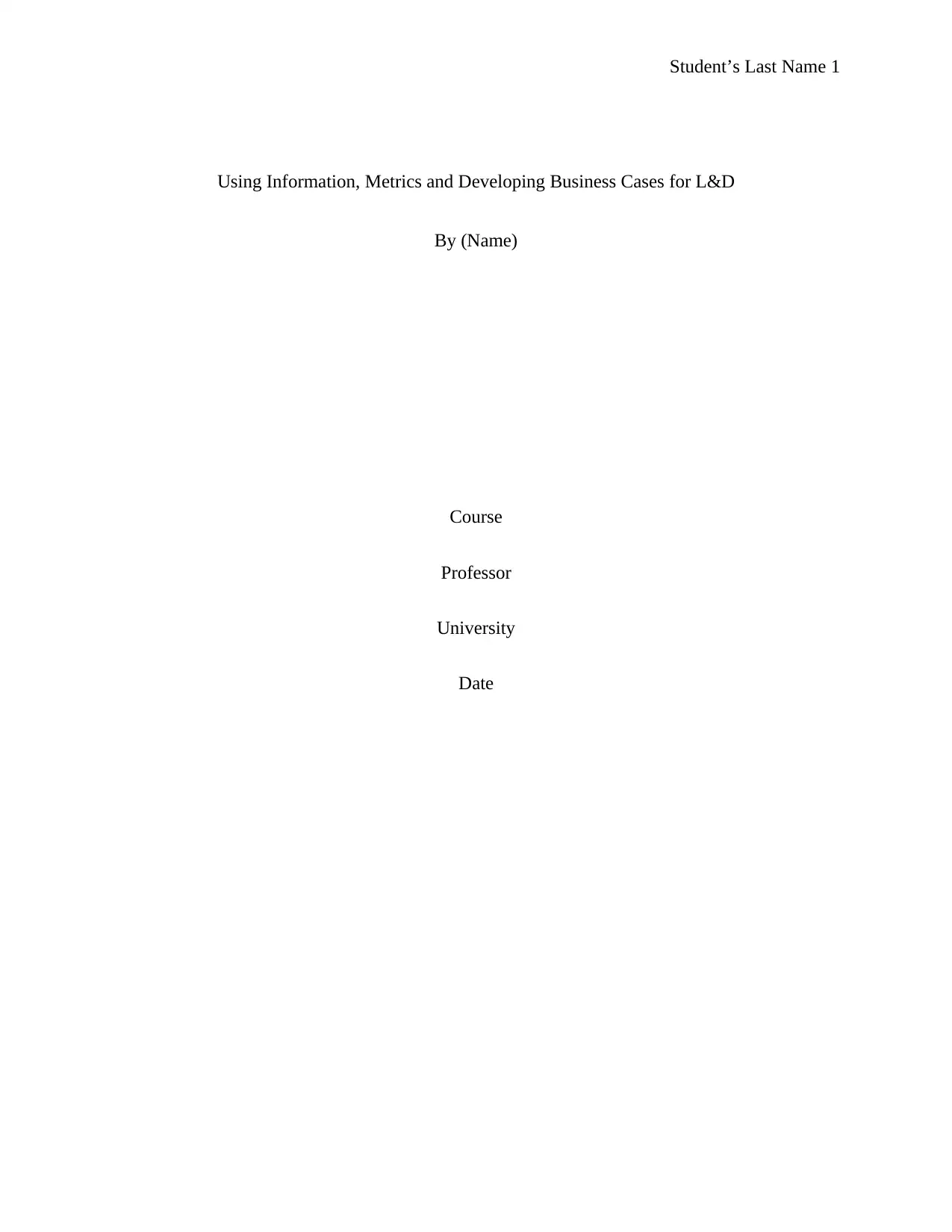
Student’s Last Name 1
Using Information, Metrics and Developing Business Cases for L&D
By (Name)
Course
Professor
University
Date
Using Information, Metrics and Developing Business Cases for L&D
By (Name)
Course
Professor
University
Date
Paraphrase This Document
Need a fresh take? Get an instant paraphrase of this document with our AI Paraphraser
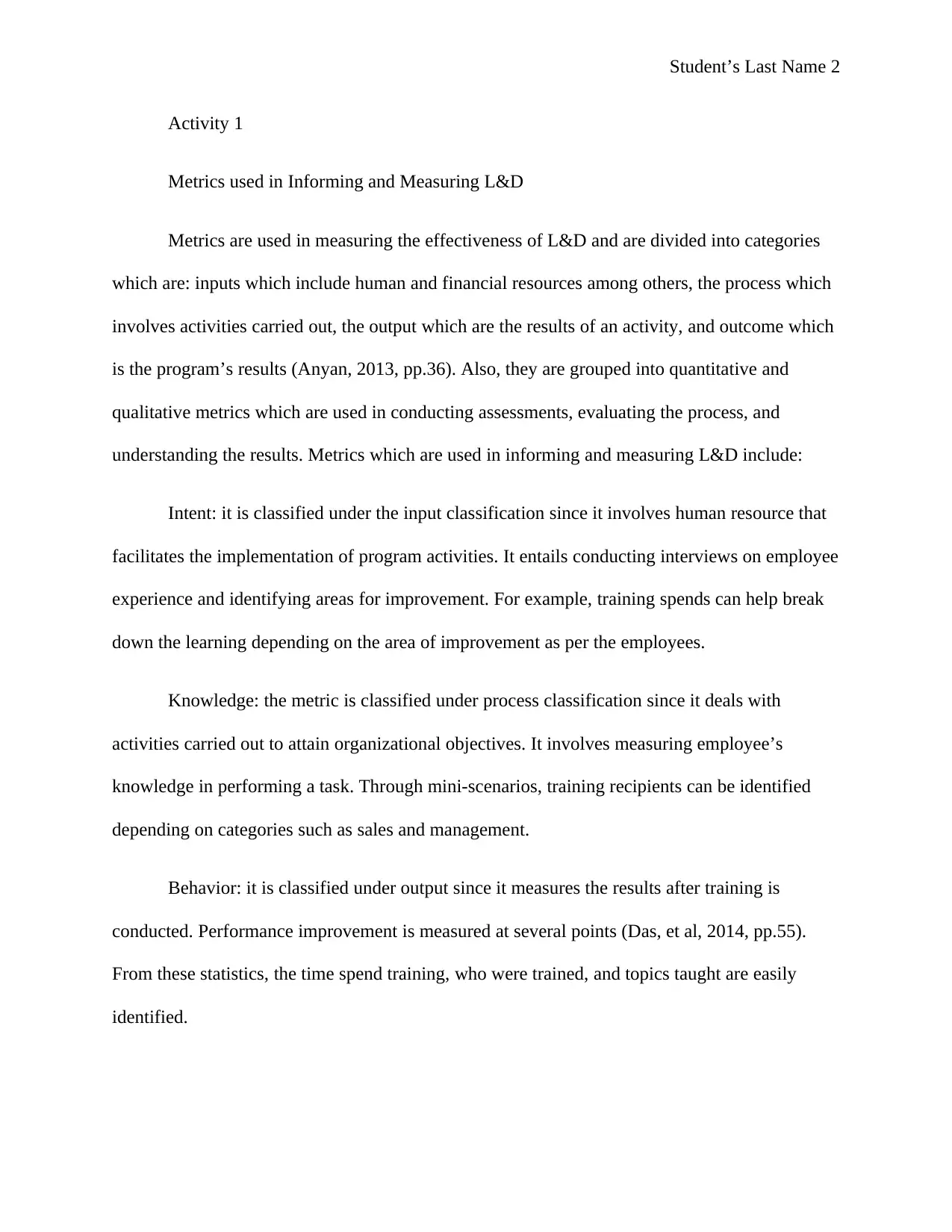
Student’s Last Name 2
Activity 1
Metrics used in Informing and Measuring L&D
Metrics are used in measuring the effectiveness of L&D and are divided into categories
which are: inputs which include human and financial resources among others, the process which
involves activities carried out, the output which are the results of an activity, and outcome which
is the program’s results (Anyan, 2013, pp.36). Also, they are grouped into quantitative and
qualitative metrics which are used in conducting assessments, evaluating the process, and
understanding the results. Metrics which are used in informing and measuring L&D include:
Intent: it is classified under the input classification since it involves human resource that
facilitates the implementation of program activities. It entails conducting interviews on employee
experience and identifying areas for improvement. For example, training spends can help break
down the learning depending on the area of improvement as per the employees.
Knowledge: the metric is classified under process classification since it deals with
activities carried out to attain organizational objectives. It involves measuring employee’s
knowledge in performing a task. Through mini-scenarios, training recipients can be identified
depending on categories such as sales and management.
Behavior: it is classified under output since it measures the results after training is
conducted. Performance improvement is measured at several points (Das, et al, 2014, pp.55).
From these statistics, the time spend training, who were trained, and topics taught are easily
identified.
Activity 1
Metrics used in Informing and Measuring L&D
Metrics are used in measuring the effectiveness of L&D and are divided into categories
which are: inputs which include human and financial resources among others, the process which
involves activities carried out, the output which are the results of an activity, and outcome which
is the program’s results (Anyan, 2013, pp.36). Also, they are grouped into quantitative and
qualitative metrics which are used in conducting assessments, evaluating the process, and
understanding the results. Metrics which are used in informing and measuring L&D include:
Intent: it is classified under the input classification since it involves human resource that
facilitates the implementation of program activities. It entails conducting interviews on employee
experience and identifying areas for improvement. For example, training spends can help break
down the learning depending on the area of improvement as per the employees.
Knowledge: the metric is classified under process classification since it deals with
activities carried out to attain organizational objectives. It involves measuring employee’s
knowledge in performing a task. Through mini-scenarios, training recipients can be identified
depending on categories such as sales and management.
Behavior: it is classified under output since it measures the results after training is
conducted. Performance improvement is measured at several points (Das, et al, 2014, pp.55).
From these statistics, the time spend training, who were trained, and topics taught are easily
identified.
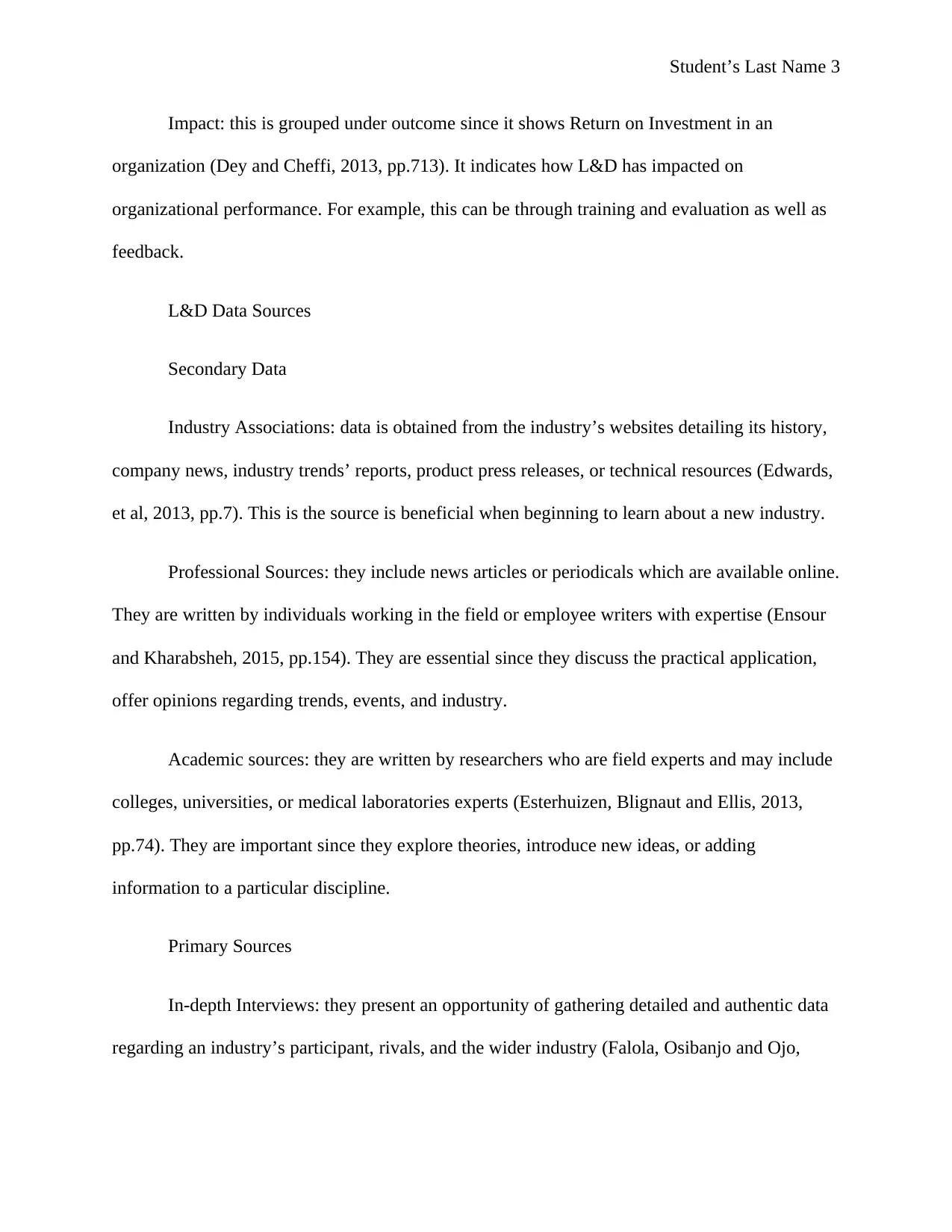
Student’s Last Name 3
Impact: this is grouped under outcome since it shows Return on Investment in an
organization (Dey and Cheffi, 2013, pp.713). It indicates how L&D has impacted on
organizational performance. For example, this can be through training and evaluation as well as
feedback.
L&D Data Sources
Secondary Data
Industry Associations: data is obtained from the industry’s websites detailing its history,
company news, industry trends’ reports, product press releases, or technical resources (Edwards,
et al, 2013, pp.7). This is the source is beneficial when beginning to learn about a new industry.
Professional Sources: they include news articles or periodicals which are available online.
They are written by individuals working in the field or employee writers with expertise (Ensour
and Kharabsheh, 2015, pp.154). They are essential since they discuss the practical application,
offer opinions regarding trends, events, and industry.
Academic sources: they are written by researchers who are field experts and may include
colleges, universities, or medical laboratories experts (Esterhuizen, Blignaut and Ellis, 2013,
pp.74). They are important since they explore theories, introduce new ideas, or adding
information to a particular discipline.
Primary Sources
In-depth Interviews: they present an opportunity of gathering detailed and authentic data
regarding an industry’s participant, rivals, and the wider industry (Falola, Osibanjo and Ojo,
Impact: this is grouped under outcome since it shows Return on Investment in an
organization (Dey and Cheffi, 2013, pp.713). It indicates how L&D has impacted on
organizational performance. For example, this can be through training and evaluation as well as
feedback.
L&D Data Sources
Secondary Data
Industry Associations: data is obtained from the industry’s websites detailing its history,
company news, industry trends’ reports, product press releases, or technical resources (Edwards,
et al, 2013, pp.7). This is the source is beneficial when beginning to learn about a new industry.
Professional Sources: they include news articles or periodicals which are available online.
They are written by individuals working in the field or employee writers with expertise (Ensour
and Kharabsheh, 2015, pp.154). They are essential since they discuss the practical application,
offer opinions regarding trends, events, and industry.
Academic sources: they are written by researchers who are field experts and may include
colleges, universities, or medical laboratories experts (Esterhuizen, Blignaut and Ellis, 2013,
pp.74). They are important since they explore theories, introduce new ideas, or adding
information to a particular discipline.
Primary Sources
In-depth Interviews: they present an opportunity of gathering detailed and authentic data
regarding an industry’s participant, rivals, and the wider industry (Falola, Osibanjo and Ojo,
⊘ This is a preview!⊘
Do you want full access?
Subscribe today to unlock all pages.

Trusted by 1+ million students worldwide
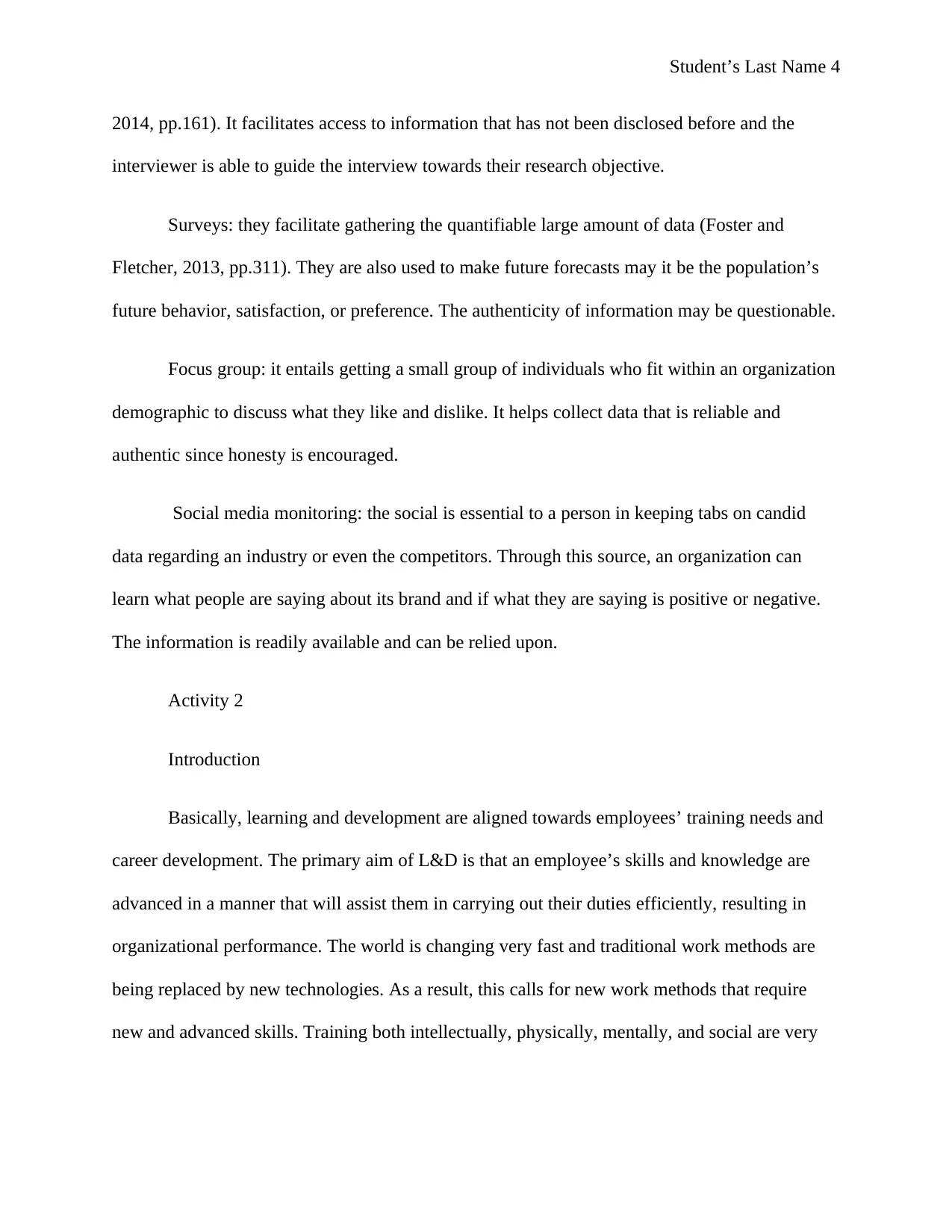
Student’s Last Name 4
2014, pp.161). It facilitates access to information that has not been disclosed before and the
interviewer is able to guide the interview towards their research objective.
Surveys: they facilitate gathering the quantifiable large amount of data (Foster and
Fletcher, 2013, pp.311). They are also used to make future forecasts may it be the population’s
future behavior, satisfaction, or preference. The authenticity of information may be questionable.
Focus group: it entails getting a small group of individuals who fit within an organization
demographic to discuss what they like and dislike. It helps collect data that is reliable and
authentic since honesty is encouraged.
Social media monitoring: the social is essential to a person in keeping tabs on candid
data regarding an industry or even the competitors. Through this source, an organization can
learn what people are saying about its brand and if what they are saying is positive or negative.
The information is readily available and can be relied upon.
Activity 2
Introduction
Basically, learning and development are aligned towards employees’ training needs and
career development. The primary aim of L&D is that an employee’s skills and knowledge are
advanced in a manner that will assist them in carrying out their duties efficiently, resulting in
organizational performance. The world is changing very fast and traditional work methods are
being replaced by new technologies. As a result, this calls for new work methods that require
new and advanced skills. Training both intellectually, physically, mentally, and social are very
2014, pp.161). It facilitates access to information that has not been disclosed before and the
interviewer is able to guide the interview towards their research objective.
Surveys: they facilitate gathering the quantifiable large amount of data (Foster and
Fletcher, 2013, pp.311). They are also used to make future forecasts may it be the population’s
future behavior, satisfaction, or preference. The authenticity of information may be questionable.
Focus group: it entails getting a small group of individuals who fit within an organization
demographic to discuss what they like and dislike. It helps collect data that is reliable and
authentic since honesty is encouraged.
Social media monitoring: the social is essential to a person in keeping tabs on candid
data regarding an industry or even the competitors. Through this source, an organization can
learn what people are saying about its brand and if what they are saying is positive or negative.
The information is readily available and can be relied upon.
Activity 2
Introduction
Basically, learning and development are aligned towards employees’ training needs and
career development. The primary aim of L&D is that an employee’s skills and knowledge are
advanced in a manner that will assist them in carrying out their duties efficiently, resulting in
organizational performance. The world is changing very fast and traditional work methods are
being replaced by new technologies. As a result, this calls for new work methods that require
new and advanced skills. Training both intellectually, physically, mentally, and social are very
Paraphrase This Document
Need a fresh take? Get an instant paraphrase of this document with our AI Paraphraser
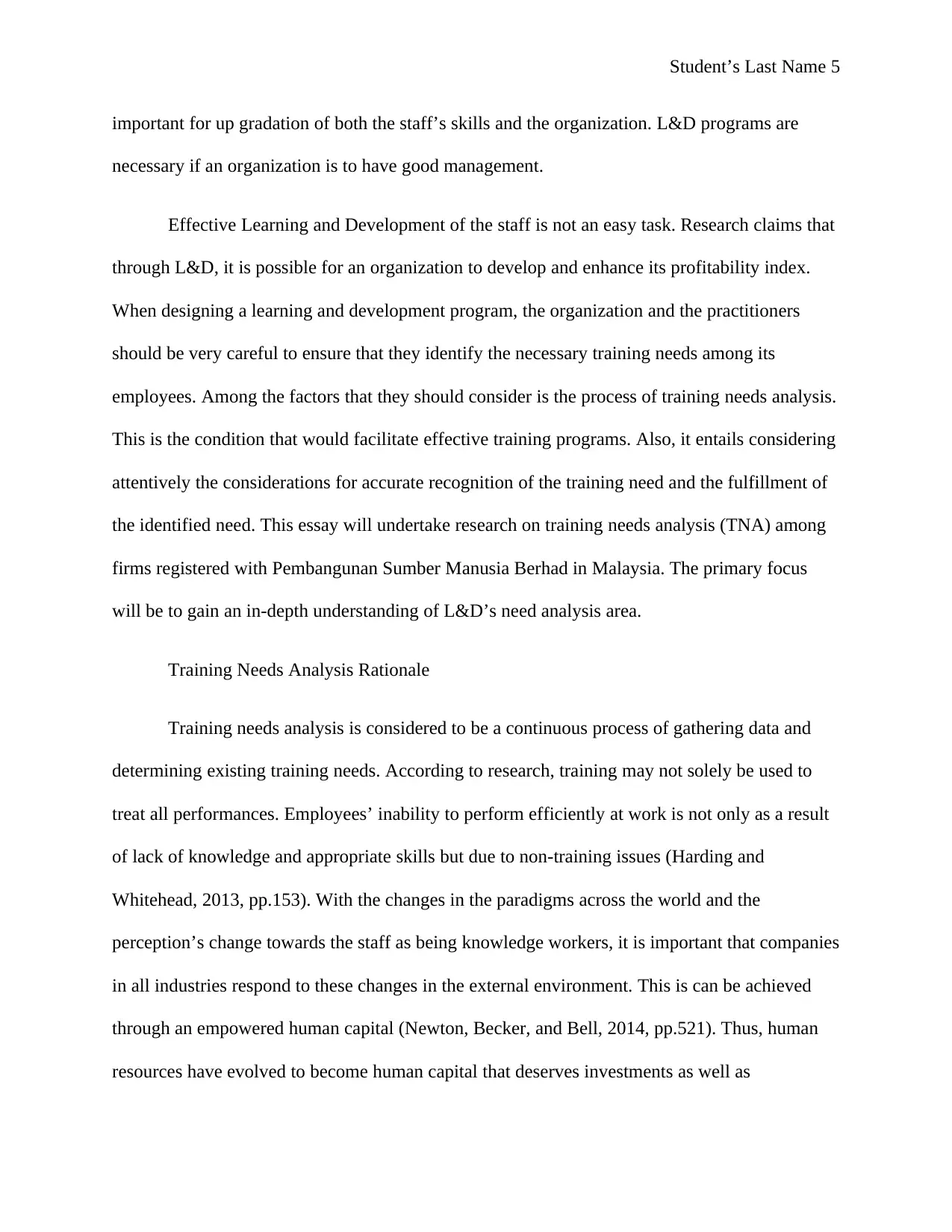
Student’s Last Name 5
important for up gradation of both the staff’s skills and the organization. L&D programs are
necessary if an organization is to have good management.
Effective Learning and Development of the staff is not an easy task. Research claims that
through L&D, it is possible for an organization to develop and enhance its profitability index.
When designing a learning and development program, the organization and the practitioners
should be very careful to ensure that they identify the necessary training needs among its
employees. Among the factors that they should consider is the process of training needs analysis.
This is the condition that would facilitate effective training programs. Also, it entails considering
attentively the considerations for accurate recognition of the training need and the fulfillment of
the identified need. This essay will undertake research on training needs analysis (TNA) among
firms registered with Pembangunan Sumber Manusia Berhad in Malaysia. The primary focus
will be to gain an in-depth understanding of L&D’s need analysis area.
Training Needs Analysis Rationale
Training needs analysis is considered to be a continuous process of gathering data and
determining existing training needs. According to research, training may not solely be used to
treat all performances. Employees’ inability to perform efficiently at work is not only as a result
of lack of knowledge and appropriate skills but due to non-training issues (Harding and
Whitehead, 2013, pp.153). With the changes in the paradigms across the world and the
perception’s change towards the staff as being knowledge workers, it is important that companies
in all industries respond to these changes in the external environment. This is can be achieved
through an empowered human capital (Newton, Becker, and Bell, 2014, pp.521). Thus, human
resources have evolved to become human capital that deserves investments as well as
important for up gradation of both the staff’s skills and the organization. L&D programs are
necessary if an organization is to have good management.
Effective Learning and Development of the staff is not an easy task. Research claims that
through L&D, it is possible for an organization to develop and enhance its profitability index.
When designing a learning and development program, the organization and the practitioners
should be very careful to ensure that they identify the necessary training needs among its
employees. Among the factors that they should consider is the process of training needs analysis.
This is the condition that would facilitate effective training programs. Also, it entails considering
attentively the considerations for accurate recognition of the training need and the fulfillment of
the identified need. This essay will undertake research on training needs analysis (TNA) among
firms registered with Pembangunan Sumber Manusia Berhad in Malaysia. The primary focus
will be to gain an in-depth understanding of L&D’s need analysis area.
Training Needs Analysis Rationale
Training needs analysis is considered to be a continuous process of gathering data and
determining existing training needs. According to research, training may not solely be used to
treat all performances. Employees’ inability to perform efficiently at work is not only as a result
of lack of knowledge and appropriate skills but due to non-training issues (Harding and
Whitehead, 2013, pp.153). With the changes in the paradigms across the world and the
perception’s change towards the staff as being knowledge workers, it is important that companies
in all industries respond to these changes in the external environment. This is can be achieved
through an empowered human capital (Newton, Becker, and Bell, 2014, pp.521). Thus, human
resources have evolved to become human capital that deserves investments as well as
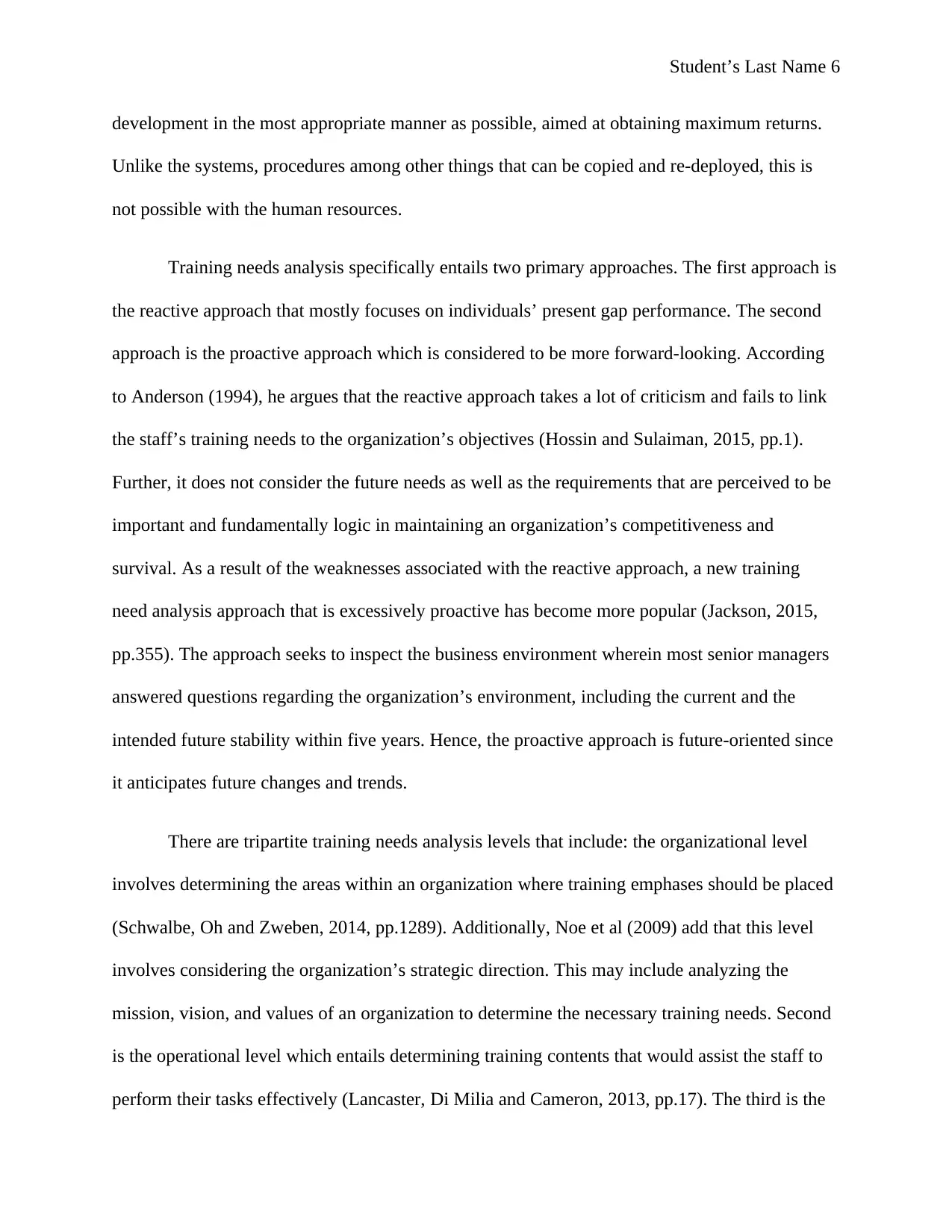
Student’s Last Name 6
development in the most appropriate manner as possible, aimed at obtaining maximum returns.
Unlike the systems, procedures among other things that can be copied and re-deployed, this is
not possible with the human resources.
Training needs analysis specifically entails two primary approaches. The first approach is
the reactive approach that mostly focuses on individuals’ present gap performance. The second
approach is the proactive approach which is considered to be more forward-looking. According
to Anderson (1994), he argues that the reactive approach takes a lot of criticism and fails to link
the staff’s training needs to the organization’s objectives (Hossin and Sulaiman, 2015, pp.1).
Further, it does not consider the future needs as well as the requirements that are perceived to be
important and fundamentally logic in maintaining an organization’s competitiveness and
survival. As a result of the weaknesses associated with the reactive approach, a new training
need analysis approach that is excessively proactive has become more popular (Jackson, 2015,
pp.355). The approach seeks to inspect the business environment wherein most senior managers
answered questions regarding the organization’s environment, including the current and the
intended future stability within five years. Hence, the proactive approach is future-oriented since
it anticipates future changes and trends.
There are tripartite training needs analysis levels that include: the organizational level
involves determining the areas within an organization where training emphases should be placed
(Schwalbe, Oh and Zweben, 2014, pp.1289). Additionally, Noe et al (2009) add that this level
involves considering the organization’s strategic direction. This may include analyzing the
mission, vision, and values of an organization to determine the necessary training needs. Second
is the operational level which entails determining training contents that would assist the staff to
perform their tasks effectively (Lancaster, Di Milia and Cameron, 2013, pp.17). The third is the
development in the most appropriate manner as possible, aimed at obtaining maximum returns.
Unlike the systems, procedures among other things that can be copied and re-deployed, this is
not possible with the human resources.
Training needs analysis specifically entails two primary approaches. The first approach is
the reactive approach that mostly focuses on individuals’ present gap performance. The second
approach is the proactive approach which is considered to be more forward-looking. According
to Anderson (1994), he argues that the reactive approach takes a lot of criticism and fails to link
the staff’s training needs to the organization’s objectives (Hossin and Sulaiman, 2015, pp.1).
Further, it does not consider the future needs as well as the requirements that are perceived to be
important and fundamentally logic in maintaining an organization’s competitiveness and
survival. As a result of the weaknesses associated with the reactive approach, a new training
need analysis approach that is excessively proactive has become more popular (Jackson, 2015,
pp.355). The approach seeks to inspect the business environment wherein most senior managers
answered questions regarding the organization’s environment, including the current and the
intended future stability within five years. Hence, the proactive approach is future-oriented since
it anticipates future changes and trends.
There are tripartite training needs analysis levels that include: the organizational level
involves determining the areas within an organization where training emphases should be placed
(Schwalbe, Oh and Zweben, 2014, pp.1289). Additionally, Noe et al (2009) add that this level
involves considering the organization’s strategic direction. This may include analyzing the
mission, vision, and values of an organization to determine the necessary training needs. Second
is the operational level which entails determining training contents that would assist the staff to
perform their tasks effectively (Lancaster, Di Milia and Cameron, 2013, pp.17). The third is the
⊘ This is a preview!⊘
Do you want full access?
Subscribe today to unlock all pages.

Trusted by 1+ million students worldwide
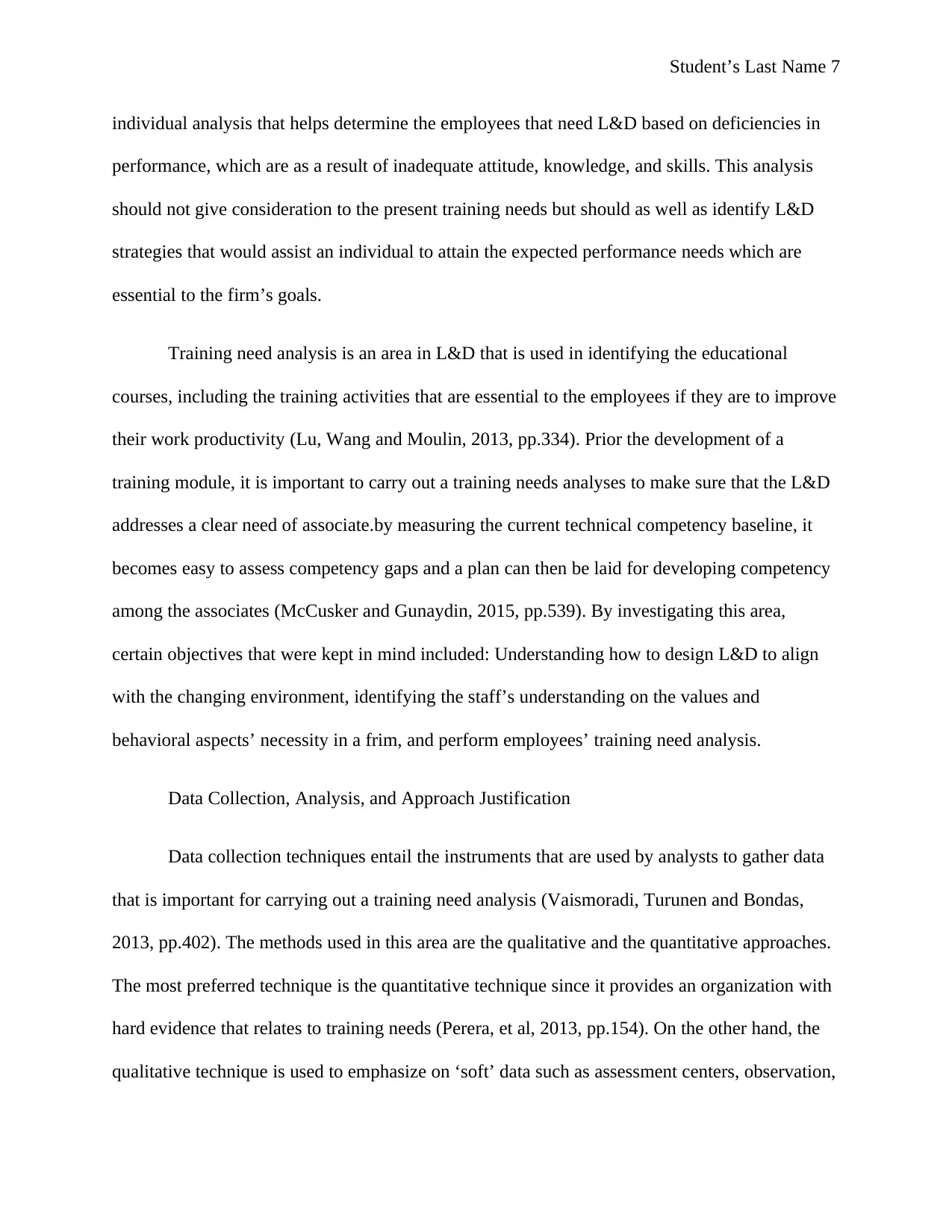
Student’s Last Name 7
individual analysis that helps determine the employees that need L&D based on deficiencies in
performance, which are as a result of inadequate attitude, knowledge, and skills. This analysis
should not give consideration to the present training needs but should as well as identify L&D
strategies that would assist an individual to attain the expected performance needs which are
essential to the firm’s goals.
Training need analysis is an area in L&D that is used in identifying the educational
courses, including the training activities that are essential to the employees if they are to improve
their work productivity (Lu, Wang and Moulin, 2013, pp.334). Prior the development of a
training module, it is important to carry out a training needs analyses to make sure that the L&D
addresses a clear need of associate.by measuring the current technical competency baseline, it
becomes easy to assess competency gaps and a plan can then be laid for developing competency
among the associates (McCusker and Gunaydin, 2015, pp.539). By investigating this area,
certain objectives that were kept in mind included: Understanding how to design L&D to align
with the changing environment, identifying the staff’s understanding on the values and
behavioral aspects’ necessity in a frim, and perform employees’ training need analysis.
Data Collection, Analysis, and Approach Justification
Data collection techniques entail the instruments that are used by analysts to gather data
that is important for carrying out a training need analysis (Vaismoradi, Turunen and Bondas,
2013, pp.402). The methods used in this area are the qualitative and the quantitative approaches.
The most preferred technique is the quantitative technique since it provides an organization with
hard evidence that relates to training needs (Perera, et al, 2013, pp.154). On the other hand, the
qualitative technique is used to emphasize on ‘soft’ data such as assessment centers, observation,
individual analysis that helps determine the employees that need L&D based on deficiencies in
performance, which are as a result of inadequate attitude, knowledge, and skills. This analysis
should not give consideration to the present training needs but should as well as identify L&D
strategies that would assist an individual to attain the expected performance needs which are
essential to the firm’s goals.
Training need analysis is an area in L&D that is used in identifying the educational
courses, including the training activities that are essential to the employees if they are to improve
their work productivity (Lu, Wang and Moulin, 2013, pp.334). Prior the development of a
training module, it is important to carry out a training needs analyses to make sure that the L&D
addresses a clear need of associate.by measuring the current technical competency baseline, it
becomes easy to assess competency gaps and a plan can then be laid for developing competency
among the associates (McCusker and Gunaydin, 2015, pp.539). By investigating this area,
certain objectives that were kept in mind included: Understanding how to design L&D to align
with the changing environment, identifying the staff’s understanding on the values and
behavioral aspects’ necessity in a frim, and perform employees’ training need analysis.
Data Collection, Analysis, and Approach Justification
Data collection techniques entail the instruments that are used by analysts to gather data
that is important for carrying out a training need analysis (Vaismoradi, Turunen and Bondas,
2013, pp.402). The methods used in this area are the qualitative and the quantitative approaches.
The most preferred technique is the quantitative technique since it provides an organization with
hard evidence that relates to training needs (Perera, et al, 2013, pp.154). On the other hand, the
qualitative technique is used to emphasize on ‘soft’ data such as assessment centers, observation,
Paraphrase This Document
Need a fresh take? Get an instant paraphrase of this document with our AI Paraphraser
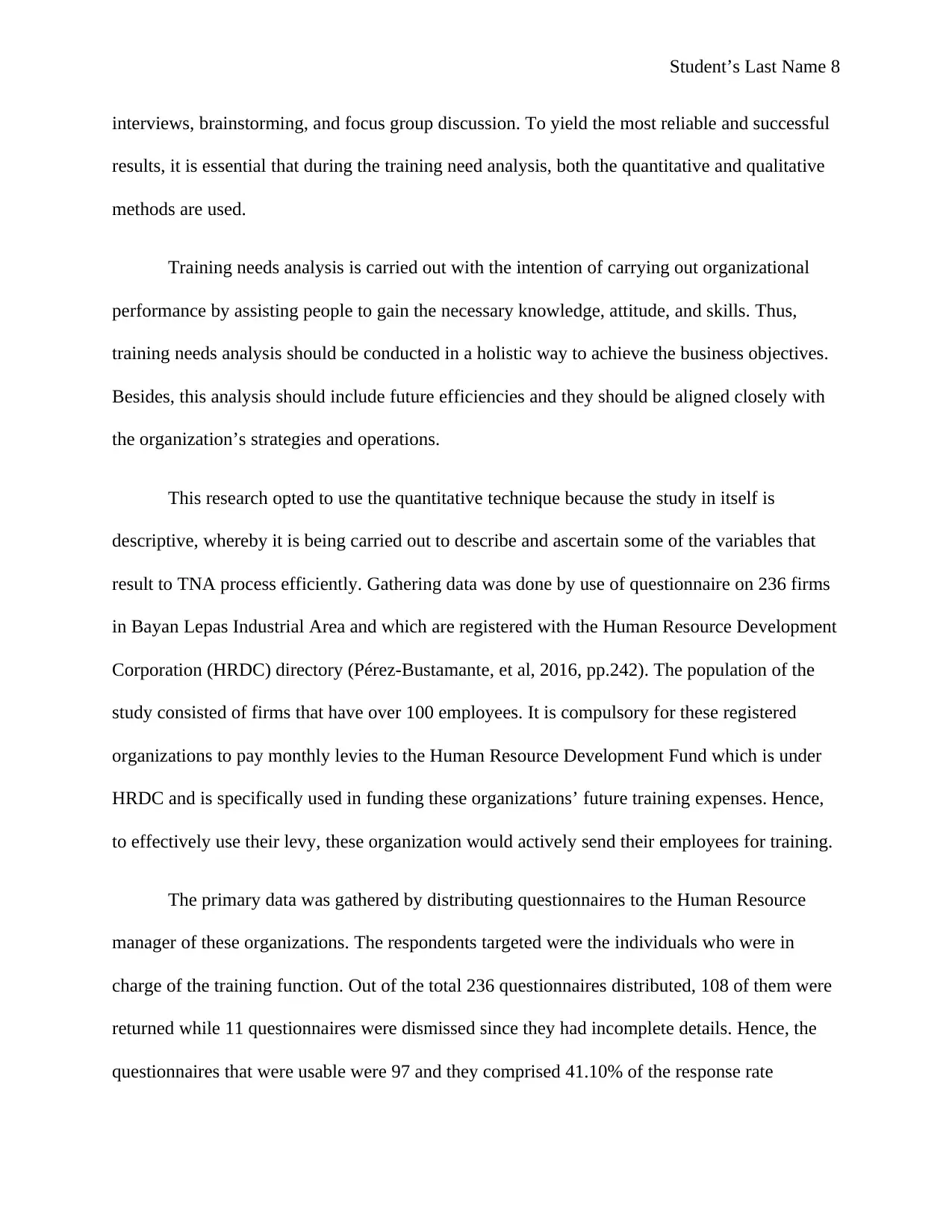
Student’s Last Name 8
interviews, brainstorming, and focus group discussion. To yield the most reliable and successful
results, it is essential that during the training need analysis, both the quantitative and qualitative
methods are used.
Training needs analysis is carried out with the intention of carrying out organizational
performance by assisting people to gain the necessary knowledge, attitude, and skills. Thus,
training needs analysis should be conducted in a holistic way to achieve the business objectives.
Besides, this analysis should include future efficiencies and they should be aligned closely with
the organization’s strategies and operations.
This research opted to use the quantitative technique because the study in itself is
descriptive, whereby it is being carried out to describe and ascertain some of the variables that
result to TNA process efficiently. Gathering data was done by use of questionnaire on 236 firms
in Bayan Lepas Industrial Area and which are registered with the Human Resource Development
Corporation (HRDC) directory (Pérez-Bustamante, et al, 2016, pp.242). The population of the
study consisted of firms that have over 100 employees. It is compulsory for these registered
organizations to pay monthly levies to the Human Resource Development Fund which is under
HRDC and is specifically used in funding these organizations’ future training expenses. Hence,
to effectively use their levy, these organization would actively send their employees for training.
The primary data was gathered by distributing questionnaires to the Human Resource
manager of these organizations. The respondents targeted were the individuals who were in
charge of the training function. Out of the total 236 questionnaires distributed, 108 of them were
returned while 11 questionnaires were dismissed since they had incomplete details. Hence, the
questionnaires that were usable were 97 and they comprised 41.10% of the response rate
interviews, brainstorming, and focus group discussion. To yield the most reliable and successful
results, it is essential that during the training need analysis, both the quantitative and qualitative
methods are used.
Training needs analysis is carried out with the intention of carrying out organizational
performance by assisting people to gain the necessary knowledge, attitude, and skills. Thus,
training needs analysis should be conducted in a holistic way to achieve the business objectives.
Besides, this analysis should include future efficiencies and they should be aligned closely with
the organization’s strategies and operations.
This research opted to use the quantitative technique because the study in itself is
descriptive, whereby it is being carried out to describe and ascertain some of the variables that
result to TNA process efficiently. Gathering data was done by use of questionnaire on 236 firms
in Bayan Lepas Industrial Area and which are registered with the Human Resource Development
Corporation (HRDC) directory (Pérez-Bustamante, et al, 2016, pp.242). The population of the
study consisted of firms that have over 100 employees. It is compulsory for these registered
organizations to pay monthly levies to the Human Resource Development Fund which is under
HRDC and is specifically used in funding these organizations’ future training expenses. Hence,
to effectively use their levy, these organization would actively send their employees for training.
The primary data was gathered by distributing questionnaires to the Human Resource
manager of these organizations. The respondents targeted were the individuals who were in
charge of the training function. Out of the total 236 questionnaires distributed, 108 of them were
returned while 11 questionnaires were dismissed since they had incomplete details. Hence, the
questionnaires that were usable were 97 and they comprised 41.10% of the response rate
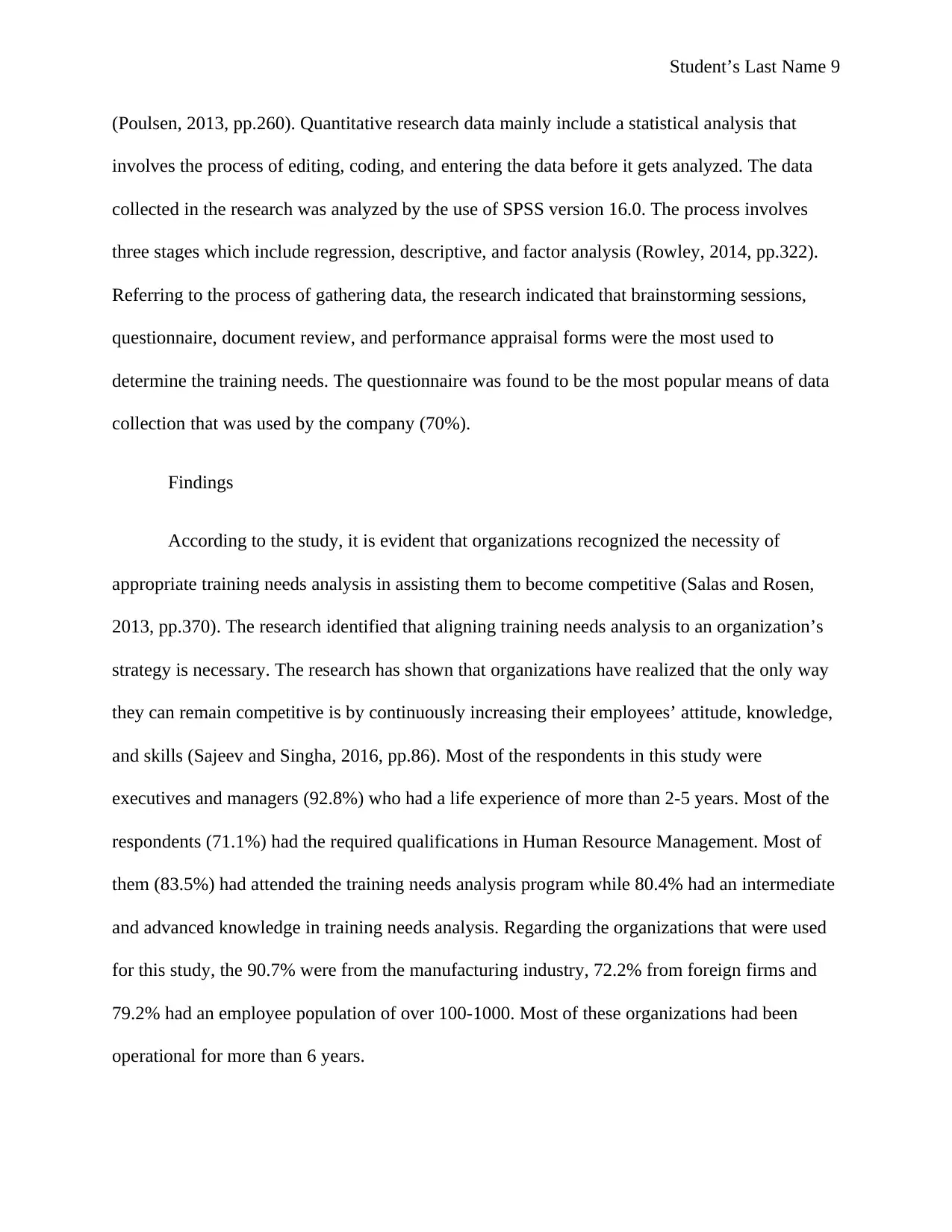
Student’s Last Name 9
(Poulsen, 2013, pp.260). Quantitative research data mainly include a statistical analysis that
involves the process of editing, coding, and entering the data before it gets analyzed. The data
collected in the research was analyzed by the use of SPSS version 16.0. The process involves
three stages which include regression, descriptive, and factor analysis (Rowley, 2014, pp.322).
Referring to the process of gathering data, the research indicated that brainstorming sessions,
questionnaire, document review, and performance appraisal forms were the most used to
determine the training needs. The questionnaire was found to be the most popular means of data
collection that was used by the company (70%).
Findings
According to the study, it is evident that organizations recognized the necessity of
appropriate training needs analysis in assisting them to become competitive (Salas and Rosen,
2013, pp.370). The research identified that aligning training needs analysis to an organization’s
strategy is necessary. The research has shown that organizations have realized that the only way
they can remain competitive is by continuously increasing their employees’ attitude, knowledge,
and skills (Sajeev and Singha, 2016, pp.86). Most of the respondents in this study were
executives and managers (92.8%) who had a life experience of more than 2-5 years. Most of the
respondents (71.1%) had the required qualifications in Human Resource Management. Most of
them (83.5%) had attended the training needs analysis program while 80.4% had an intermediate
and advanced knowledge in training needs analysis. Regarding the organizations that were used
for this study, the 90.7% were from the manufacturing industry, 72.2% from foreign firms and
79.2% had an employee population of over 100-1000. Most of these organizations had been
operational for more than 6 years.
(Poulsen, 2013, pp.260). Quantitative research data mainly include a statistical analysis that
involves the process of editing, coding, and entering the data before it gets analyzed. The data
collected in the research was analyzed by the use of SPSS version 16.0. The process involves
three stages which include regression, descriptive, and factor analysis (Rowley, 2014, pp.322).
Referring to the process of gathering data, the research indicated that brainstorming sessions,
questionnaire, document review, and performance appraisal forms were the most used to
determine the training needs. The questionnaire was found to be the most popular means of data
collection that was used by the company (70%).
Findings
According to the study, it is evident that organizations recognized the necessity of
appropriate training needs analysis in assisting them to become competitive (Salas and Rosen,
2013, pp.370). The research identified that aligning training needs analysis to an organization’s
strategy is necessary. The research has shown that organizations have realized that the only way
they can remain competitive is by continuously increasing their employees’ attitude, knowledge,
and skills (Sajeev and Singha, 2016, pp.86). Most of the respondents in this study were
executives and managers (92.8%) who had a life experience of more than 2-5 years. Most of the
respondents (71.1%) had the required qualifications in Human Resource Management. Most of
them (83.5%) had attended the training needs analysis program while 80.4% had an intermediate
and advanced knowledge in training needs analysis. Regarding the organizations that were used
for this study, the 90.7% were from the manufacturing industry, 72.2% from foreign firms and
79.2% had an employee population of over 100-1000. Most of these organizations had been
operational for more than 6 years.
⊘ This is a preview!⊘
Do you want full access?
Subscribe today to unlock all pages.

Trusted by 1+ million students worldwide
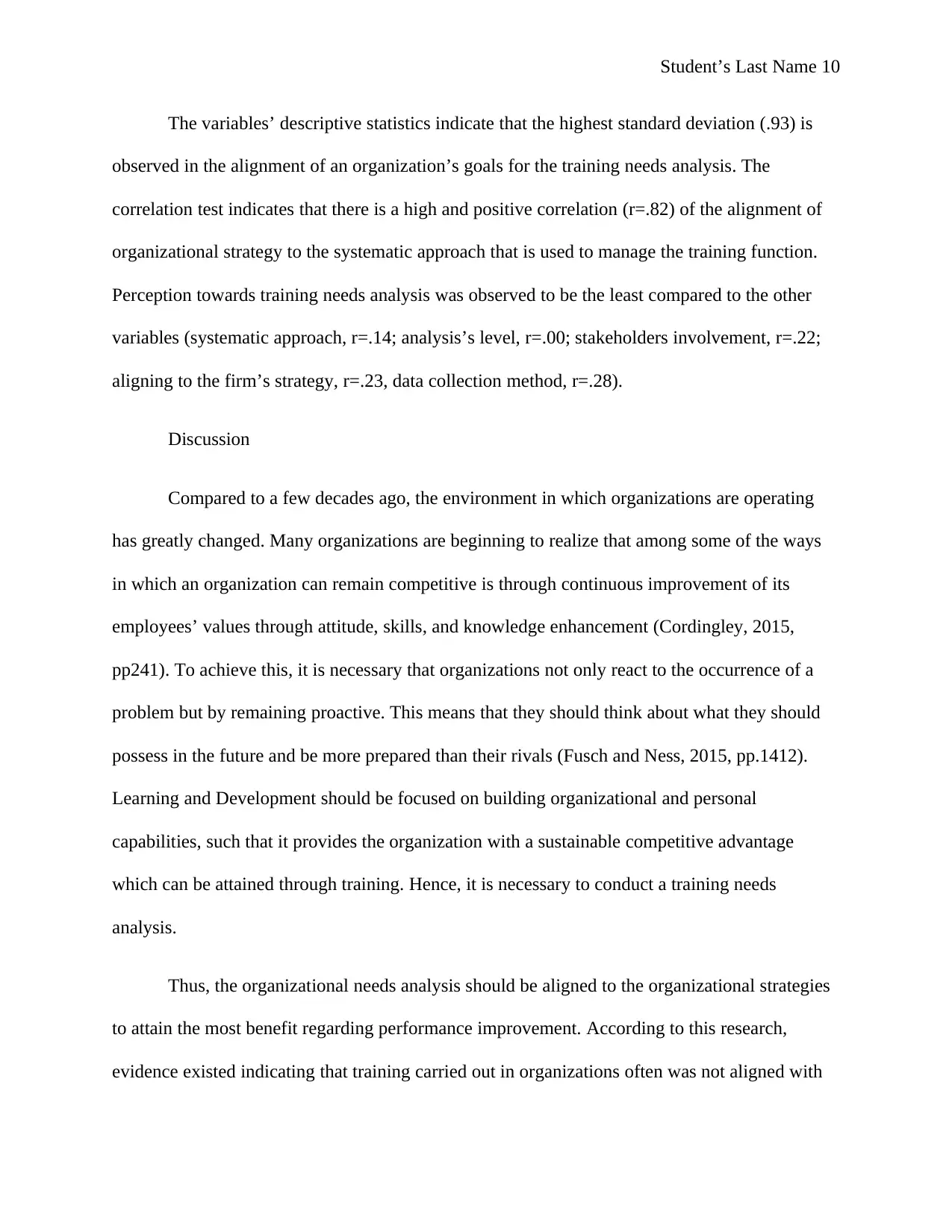
Student’s Last Name 10
The variables’ descriptive statistics indicate that the highest standard deviation (.93) is
observed in the alignment of an organization’s goals for the training needs analysis. The
correlation test indicates that there is a high and positive correlation (r=.82) of the alignment of
organizational strategy to the systematic approach that is used to manage the training function.
Perception towards training needs analysis was observed to be the least compared to the other
variables (systematic approach, r=.14; analysis’s level, r=.00; stakeholders involvement, r=.22;
aligning to the firm’s strategy, r=.23, data collection method, r=.28).
Discussion
Compared to a few decades ago, the environment in which organizations are operating
has greatly changed. Many organizations are beginning to realize that among some of the ways
in which an organization can remain competitive is through continuous improvement of its
employees’ values through attitude, skills, and knowledge enhancement (Cordingley, 2015,
pp241). To achieve this, it is necessary that organizations not only react to the occurrence of a
problem but by remaining proactive. This means that they should think about what they should
possess in the future and be more prepared than their rivals (Fusch and Ness, 2015, pp.1412).
Learning and Development should be focused on building organizational and personal
capabilities, such that it provides the organization with a sustainable competitive advantage
which can be attained through training. Hence, it is necessary to conduct a training needs
analysis.
Thus, the organizational needs analysis should be aligned to the organizational strategies
to attain the most benefit regarding performance improvement. According to this research,
evidence existed indicating that training carried out in organizations often was not aligned with
The variables’ descriptive statistics indicate that the highest standard deviation (.93) is
observed in the alignment of an organization’s goals for the training needs analysis. The
correlation test indicates that there is a high and positive correlation (r=.82) of the alignment of
organizational strategy to the systematic approach that is used to manage the training function.
Perception towards training needs analysis was observed to be the least compared to the other
variables (systematic approach, r=.14; analysis’s level, r=.00; stakeholders involvement, r=.22;
aligning to the firm’s strategy, r=.23, data collection method, r=.28).
Discussion
Compared to a few decades ago, the environment in which organizations are operating
has greatly changed. Many organizations are beginning to realize that among some of the ways
in which an organization can remain competitive is through continuous improvement of its
employees’ values through attitude, skills, and knowledge enhancement (Cordingley, 2015,
pp241). To achieve this, it is necessary that organizations not only react to the occurrence of a
problem but by remaining proactive. This means that they should think about what they should
possess in the future and be more prepared than their rivals (Fusch and Ness, 2015, pp.1412).
Learning and Development should be focused on building organizational and personal
capabilities, such that it provides the organization with a sustainable competitive advantage
which can be attained through training. Hence, it is necessary to conduct a training needs
analysis.
Thus, the organizational needs analysis should be aligned to the organizational strategies
to attain the most benefit regarding performance improvement. According to this research,
evidence existed indicating that training carried out in organizations often was not aligned with
Paraphrase This Document
Need a fresh take? Get an instant paraphrase of this document with our AI Paraphraser
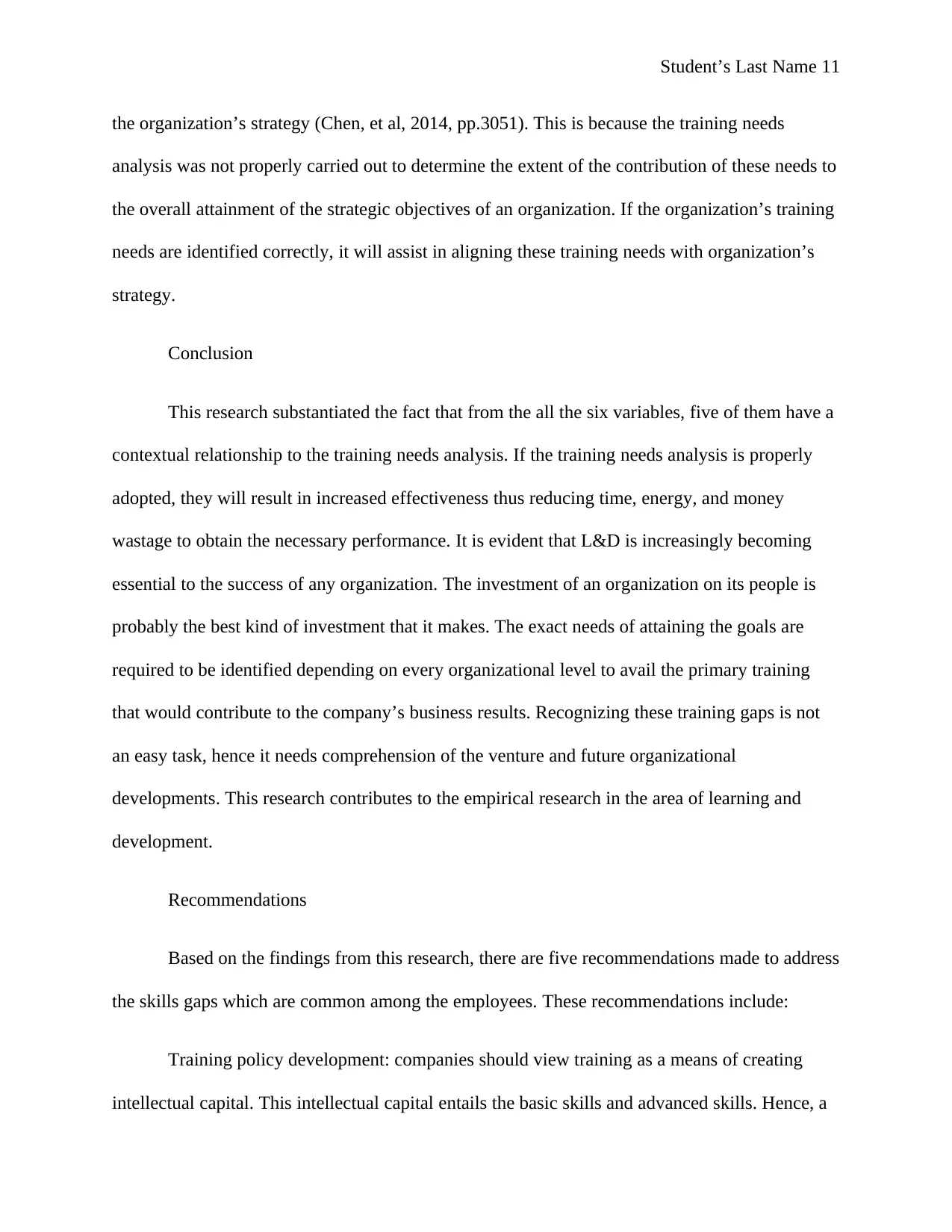
Student’s Last Name 11
the organization’s strategy (Chen, et al, 2014, pp.3051). This is because the training needs
analysis was not properly carried out to determine the extent of the contribution of these needs to
the overall attainment of the strategic objectives of an organization. If the organization’s training
needs are identified correctly, it will assist in aligning these training needs with organization’s
strategy.
Conclusion
This research substantiated the fact that from the all the six variables, five of them have a
contextual relationship to the training needs analysis. If the training needs analysis is properly
adopted, they will result in increased effectiveness thus reducing time, energy, and money
wastage to obtain the necessary performance. It is evident that L&D is increasingly becoming
essential to the success of any organization. The investment of an organization on its people is
probably the best kind of investment that it makes. The exact needs of attaining the goals are
required to be identified depending on every organizational level to avail the primary training
that would contribute to the company’s business results. Recognizing these training gaps is not
an easy task, hence it needs comprehension of the venture and future organizational
developments. This research contributes to the empirical research in the area of learning and
development.
Recommendations
Based on the findings from this research, there are five recommendations made to address
the skills gaps which are common among the employees. These recommendations include:
Training policy development: companies should view training as a means of creating
intellectual capital. This intellectual capital entails the basic skills and advanced skills. Hence, a
the organization’s strategy (Chen, et al, 2014, pp.3051). This is because the training needs
analysis was not properly carried out to determine the extent of the contribution of these needs to
the overall attainment of the strategic objectives of an organization. If the organization’s training
needs are identified correctly, it will assist in aligning these training needs with organization’s
strategy.
Conclusion
This research substantiated the fact that from the all the six variables, five of them have a
contextual relationship to the training needs analysis. If the training needs analysis is properly
adopted, they will result in increased effectiveness thus reducing time, energy, and money
wastage to obtain the necessary performance. It is evident that L&D is increasingly becoming
essential to the success of any organization. The investment of an organization on its people is
probably the best kind of investment that it makes. The exact needs of attaining the goals are
required to be identified depending on every organizational level to avail the primary training
that would contribute to the company’s business results. Recognizing these training gaps is not
an easy task, hence it needs comprehension of the venture and future organizational
developments. This research contributes to the empirical research in the area of learning and
development.
Recommendations
Based on the findings from this research, there are five recommendations made to address
the skills gaps which are common among the employees. These recommendations include:
Training policy development: companies should view training as a means of creating
intellectual capital. This intellectual capital entails the basic skills and advanced skills. Hence, a
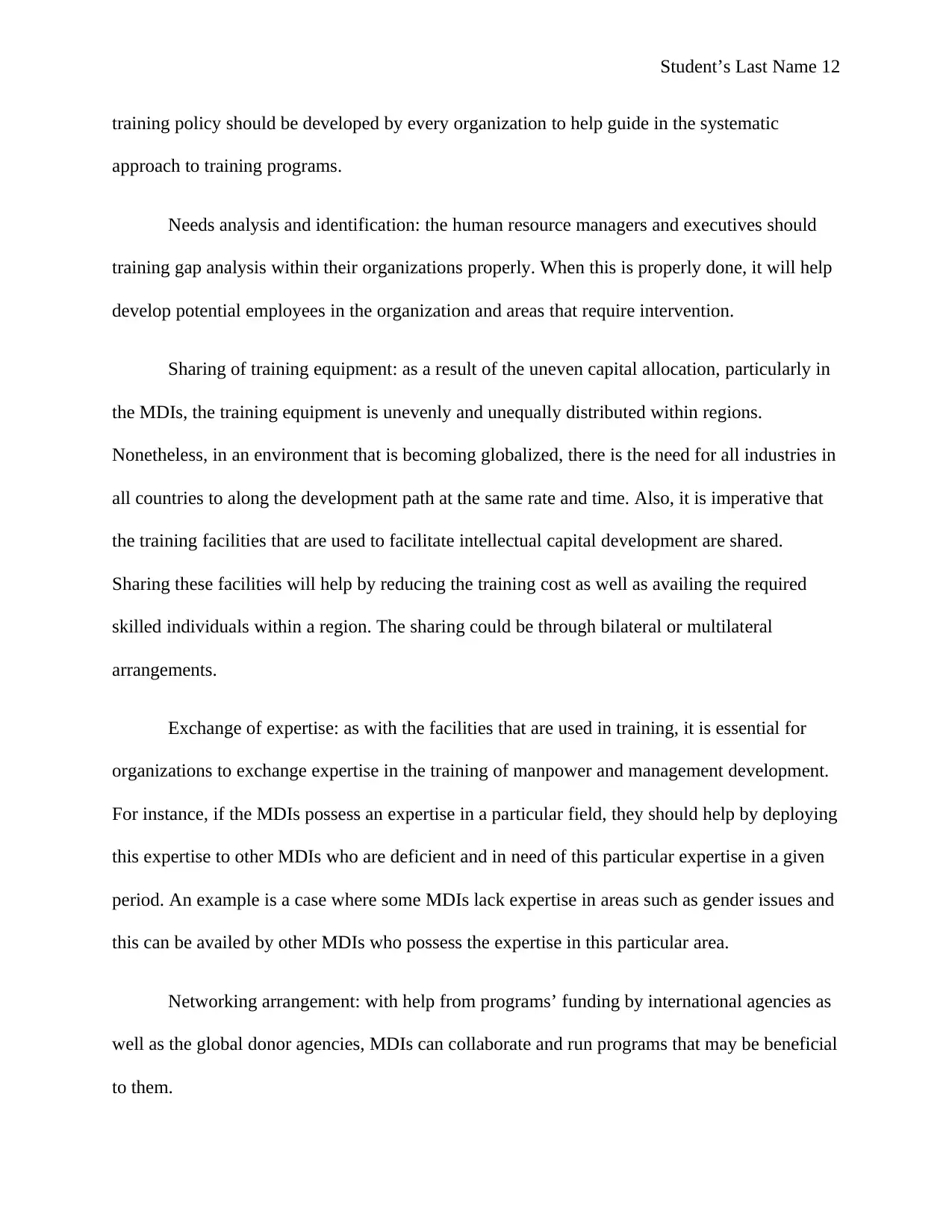
Student’s Last Name 12
training policy should be developed by every organization to help guide in the systematic
approach to training programs.
Needs analysis and identification: the human resource managers and executives should
training gap analysis within their organizations properly. When this is properly done, it will help
develop potential employees in the organization and areas that require intervention.
Sharing of training equipment: as a result of the uneven capital allocation, particularly in
the MDIs, the training equipment is unevenly and unequally distributed within regions.
Nonetheless, in an environment that is becoming globalized, there is the need for all industries in
all countries to along the development path at the same rate and time. Also, it is imperative that
the training facilities that are used to facilitate intellectual capital development are shared.
Sharing these facilities will help by reducing the training cost as well as availing the required
skilled individuals within a region. The sharing could be through bilateral or multilateral
arrangements.
Exchange of expertise: as with the facilities that are used in training, it is essential for
organizations to exchange expertise in the training of manpower and management development.
For instance, if the MDIs possess an expertise in a particular field, they should help by deploying
this expertise to other MDIs who are deficient and in need of this particular expertise in a given
period. An example is a case where some MDIs lack expertise in areas such as gender issues and
this can be availed by other MDIs who possess the expertise in this particular area.
Networking arrangement: with help from programs’ funding by international agencies as
well as the global donor agencies, MDIs can collaborate and run programs that may be beneficial
to them.
training policy should be developed by every organization to help guide in the systematic
approach to training programs.
Needs analysis and identification: the human resource managers and executives should
training gap analysis within their organizations properly. When this is properly done, it will help
develop potential employees in the organization and areas that require intervention.
Sharing of training equipment: as a result of the uneven capital allocation, particularly in
the MDIs, the training equipment is unevenly and unequally distributed within regions.
Nonetheless, in an environment that is becoming globalized, there is the need for all industries in
all countries to along the development path at the same rate and time. Also, it is imperative that
the training facilities that are used to facilitate intellectual capital development are shared.
Sharing these facilities will help by reducing the training cost as well as availing the required
skilled individuals within a region. The sharing could be through bilateral or multilateral
arrangements.
Exchange of expertise: as with the facilities that are used in training, it is essential for
organizations to exchange expertise in the training of manpower and management development.
For instance, if the MDIs possess an expertise in a particular field, they should help by deploying
this expertise to other MDIs who are deficient and in need of this particular expertise in a given
period. An example is a case where some MDIs lack expertise in areas such as gender issues and
this can be availed by other MDIs who possess the expertise in this particular area.
Networking arrangement: with help from programs’ funding by international agencies as
well as the global donor agencies, MDIs can collaborate and run programs that may be beneficial
to them.
⊘ This is a preview!⊘
Do you want full access?
Subscribe today to unlock all pages.

Trusted by 1+ million students worldwide
1 out of 17
Related Documents
Your All-in-One AI-Powered Toolkit for Academic Success.
+13062052269
info@desklib.com
Available 24*7 on WhatsApp / Email
![[object Object]](/_next/static/media/star-bottom.7253800d.svg)
Unlock your academic potential
Copyright © 2020–2025 A2Z Services. All Rights Reserved. Developed and managed by ZUCOL.





